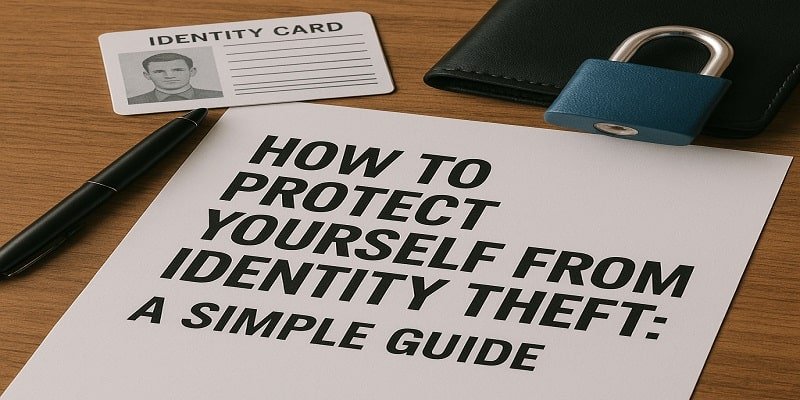“How to Protect Yourself From Identity Theft”
How to Protect Yourself From Identity Theft: Identity theft is a growing problem in the U.S., affecting millions of people each year. Criminals steal your personal information—like your Social Security number, credit card details, or bank account information—to commit fraud, open accounts in your name, or even take out loans. The consequences can be devastating, hurting your credit score, damaging your finances, and taking months (or even years) to fix.
The good news? You can take steps to protect yourself from identity theft and reduce your risk. In this guide, we’ll explain simple, effective ways to keep your personal information safe.
What is identity theft?
Identity theft is when someone uses your personal or financial information without your permission. Thieves can:
- Open new credit cards or loans in your name.
- Withdraw money from your bank accounts.
- Can file fraudulent tax returns to steal refunds.
- Can use your health insurance to pay for medical care.
- Can even give your name to the police during an arrest!
Once your information is stolen, getting it back can be stressful and time-consuming. That’s why preventing identity theft is so important.
How Identity Thieves Get Your Information
Before we discuss security tips, let’s look at how criminals steal identities:
1. Data breaches – Hackers break into a company database (such as a bank, retailer, or hospital) and steal customer data.
2. Phishing scams – Trick you into giving up passwords or credit card numbers through fake emails, texts, or calls.
3. Mail theft – Thieves steal bank statements, tax documents, or pre-approved credit offers from your mailbox.
4. Public Wi-Fi hacking – Unsecured networks let criminals spy on your online activity.
5. Shoulder surfing – someone watches you enter a PIN or password in public.
6. Dumpster diving – old bills, receipts, and documents containing sensitive information are pulled from the trash.
Now that you know the risks, let’s talk about how to protect yourself from identity theft.
10 Ways to Protect Yourself From Identity Theft
1. Freeze Your Credit
A credit freeze locks your credit report so that no one (including you) can open a new account without unlocking it. It’s free and one of the best ways to prevent identity theft.
Contact the three major credit bureaus:
2. Use Strong, Unique Passwords
Weak passwords make hacking easier. Follow these tips:
- Enable two-factor authentication (2FA) for added security.
3. Monitor your accounts and credit reports
Check your bank and credit card statements weekly for suspicious charges. You’re also entitled to one free credit report per year from each bureau at AnnualCreditReport.com.
4. Shred sensitive documents
Don’t just throw away old bills, tax forms, or bank statements—shred them to deter trash-diving.
5. Beware of phishing scams
If an email or text asks for personal information, don’t click the link. Instead, go directly to the company’s website or call their official number.
6. Keep your mail secure
- Use a locked mailbox.
- Sign up for USPS Informed Delivery to track incoming mail.
- Opt for paperless billing whenever possible.
7. Use a VPN on public Wi-Fi
Public Wi-Fi (like at coffee shops) is risky. VPNs (virtual private networks) encrypt your connection so hackers can’t steal data.
8. Limit what you share online
Avoid posting your full birth date, address, or vacation plans on social media—scammers use this information to impersonate you.
9. Set up fraud notifications
If you suspect fraud, file a fraud report with the credit bureaus. This lets lenders verify your identity before approving a loan.
10. Consider identity theft protection services
Companies like LifeLock or IdentityForce monitor your personal information and alert you to suspicious activity.
What to do if you’re a victim of identity theft
Despite precautions, identity theft can happen. If you suspect fraud:
1. Report it to the Federal Trade Commission (FTC).
2. Contact your bank and credit card companies to freeze accounts.
3. File a police report for official documentation.
4. Dispute fraudulent charges with the credit bureaus.
The sooner you act, the sooner you can recover.
Final Thoughts: How to Protect Yourself From Identity Theft
Identity theft can be scary, but you can protect yourself by being vigilant and taking a few simple precautions. Freezing your credit cards, using strong passwords, and monitoring your accounts are some of the best ways to prevent identity theft.
Be informed, be vigilant, and don’t wait until it’s too late—start protecting your personal information today!
Did you find this guide helpful? Share this with your friends and family so they can stay safe too!
FAQs About How to Protect Yourself From Identity Theft
1. What is identity theft?
Identity theft occurs when someone steals your personal information (such as your Social Security number, credit card details, or bank account information) to commit fraud, open accounts in your name, or make unauthorized purchases.
2. How can I check if my identity has been stolen?
Keep an eye on your bank and credit card statements for unusual charges, check your credit report for unfamiliar accounts, and keep an eye out for unexpected bills or collections notices. You can get a free credit report at AnnualCreditReport.com.
3. What is the best way to protect yourself from identity theft?
Freeze your credit, use strong passwords, enable two-factor authentication (2FA), shred sensitive documents, and beware of phishing scams.
4. What should I do if I become a victim of identity theft?
Report it to the FTC at IdentityTheft.gov, contact your bank and credit bureaus, file a police report, and immediately dispute fraudulent charges.
5. Is a credit freeze the same as a fraud alert?
No—a credit freeze locks your credit completely, while a fraud alert requires lenders to verify your identity before approving credit. A freeze is more effective, but both help prevent identity theft.
Have more questions? Stay vigilant and keep your personal information safe!


